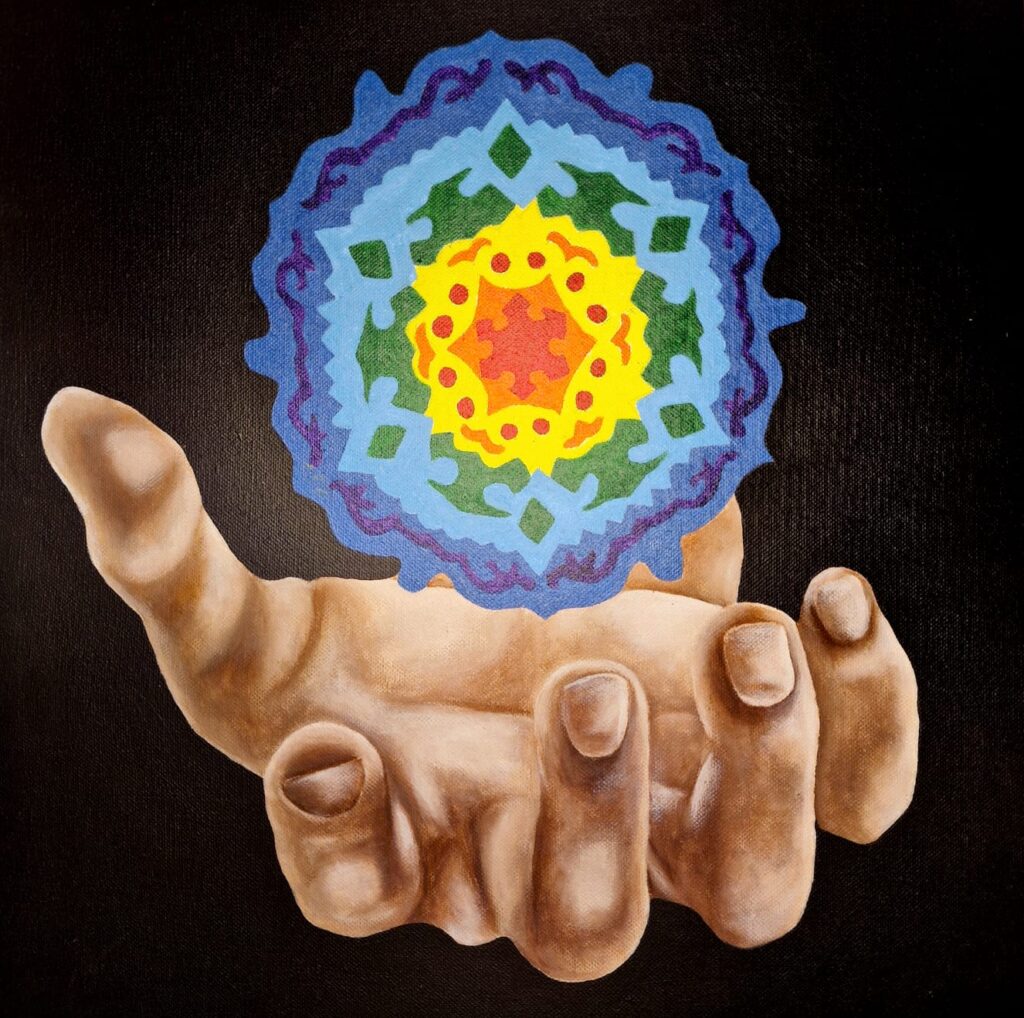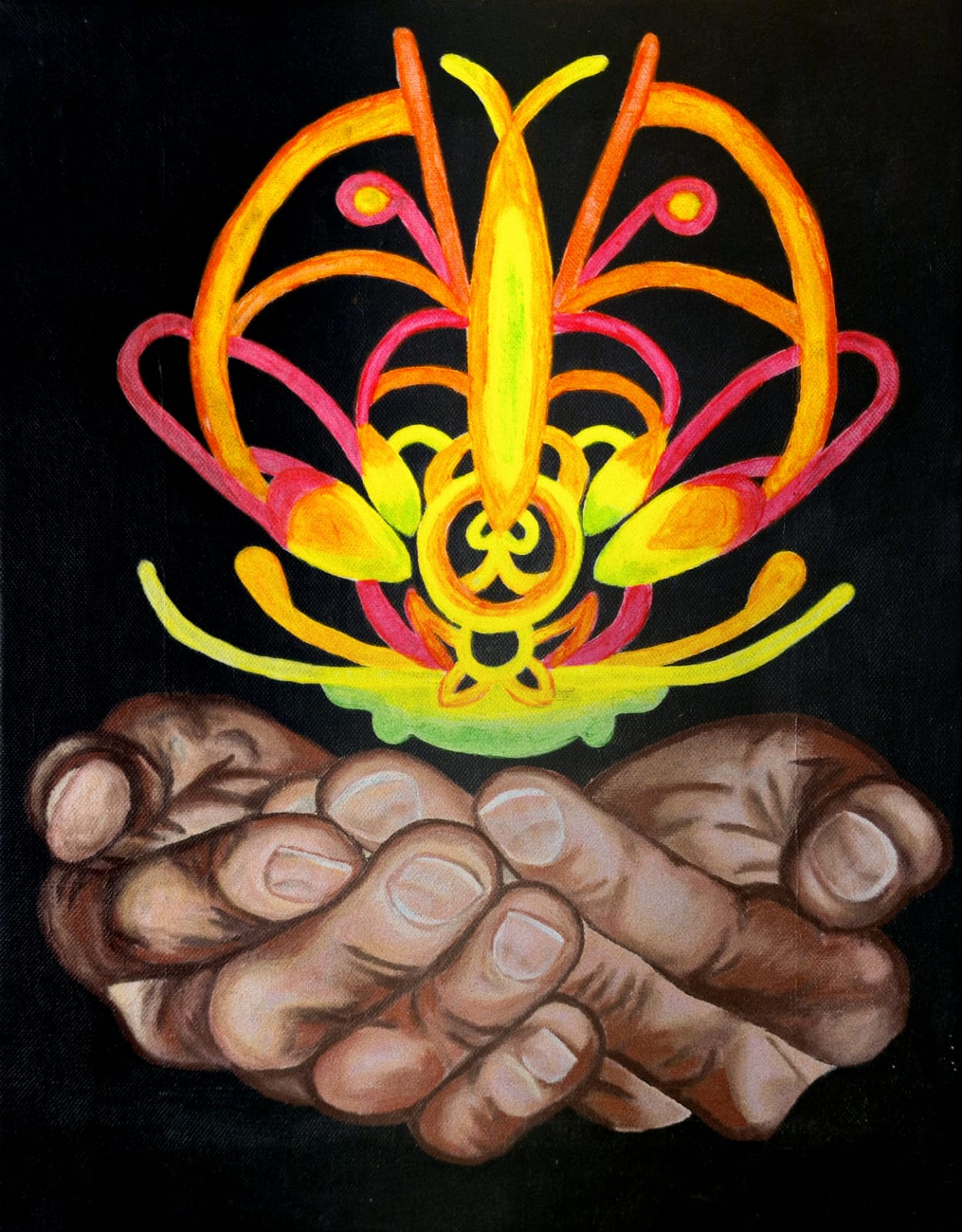The Parable of the Tenth Man
(A version adapted from the words of Swami Tadatmananda)
In ancient times in India, young boys were often sent to study at a Gurukulam (a traditional school), where they lived and studied with their guru until age 24.
This story concerns ten boys who were studying at their Gurukulam. At one point, the boys expressed an interest in attending festival celebrations at a nearby temple two days’ walk away. The guru was too old to travel and as such, was not able to accompany the boys. So, he gave his students directions to the village and appointed one of the boys to lead the group and ensure their safe arrival.
The boys embarked on their journey, taking them through forests, over hills, and across rivers. They came upon a river that was flowing swiftly and was too deep to wade across. The boy who was leading the group suggested that they all hold hands and carefully make their way across the river. They did so, but the current was so strong that the boys were quickly separated. One by one, they swam across as best they could and scrambled up the banks on the other side of the river, dripping wet and frightened from their experience. The leader instructed them to form a line for a headcount to ensure everyone had crossed the river safely.
The boy counted, “One, two, three…” until he got to nine. “Nine?” he said, “Where is the tenth boy!?”
He had them line up differently and started the count again, and again the count was nine. One of the other boys shouted, “You don’t know how to count, let me count!” and shoved his way to the top of the line. He counted, “One, two, three…” until he got to nine. “Nine?” he said, “Where is the tenth boy!?” A third boy stepped forward and tried his hand at counting. “One, two, three…” until he got to nine. “Nine?” he said, “Where is the tenth boy!?” Each of the ten boys counted, and each of the ten boys only counted nine; each having failed to count himself.
“Nine! Nine!’ they all cried out. “One boy did not make it across! One boy is lost! One boy has drowned!” The boys all ran around in a frenzied panic, beating the bushes, looking, screaming, and crying for the tenth boy. And the leader? He was banging his head on a tree. “What will my guru say? What will the boy’s parents think? I took responsibility and now one of our classmates has drowned.”
They searched downstream. They searched upstream. They searched, and they searched, and they searched, but they could not find the missing boy. After hours of fruitless searching, the boys fell to the ground, exhausted and sobbing. Having failed to find their classmate, they concluded that the tenth boy must be dead; drowned in the river and his body swept away by the current.
At this point, a wise old man passing by noticed the distressed boys. “What happened?” he asked. The boy who led the group narrated their tragic story, weeping in utter despair, “I took responsibility for the group and now one of us is lost. One of us has drowned in the river.”
The wise old man, having mentally counted the boys while listening to the story, understood what had happened and said, “Why are you crying? The tenth boy is here now.” The boys all looked around in disbelief. “Where is he? He is here now?” They looked around but none of them could see the missing boy. The leader, sceptical but desperate with despair, said, “Please sir, help us if you can.”
The old man called the leader over to his side and said, “Count.” The leader thought, “Well, this is a waste of time! We have already counted, over and over again!” but out of total desperation, he obliged. “One, two, three…” he counted until he got to nine. The old man then started to count. “One, two, three…” until he got to nine. Arriving at the leader, the old man said, “Ten. You are the tenth boy.”
The leader exclaimed joyfully, “I am the tenth boy!” and all the boys echoed, “I am the tenth boy!”
How misdirected is our search for happiness through conventional worldly activities? This parable demonstrates the irony of this pursuit. When we look for happiness outside of ourselves, knowing that the true source of happiness is within yet failing to recognise that truth about ourselves, we focus our attention outside in the world and we start chasing around for whatever we think happens to be the source of happiness. How utterly misdirected and ironic?
Some might argue, “Yes, happiness may not be found externally, but so what? There are still tiny amounts of happiness – glimpses – that I get from external things. Let it be!” Well, look at where the boys were – they were surrounded by a stunning landscape featuring forests, rivers, and hills. Were they enjoying themselves while they ran around in panic, looking for their missing classmate? They were miserable! They felt so much stress and anxiety that they were not having fun at all.
How are we doing, running through life looking for happiness? No doubt, we catch momentary glimpses and enjoy things, but overall, it is kind of stressful. Isn’t it? There are so many things that we want – so many obstacles to fulfilling our desires. It requires so much effort. After spending the day running around searching, the boys were exhausted. Think about if you have ever felt exhausted, from running around like these boys, in a futile search for what is already here, now.
When the wise old man first told the boys the truth, did their problem go away? No, they were still looking in the wrong place. In the same way, people can tell you the truth (such as “the source of happiness is within you”) but it does not solve your problem. Merely hearing the truth is not enough.
The job of a teacher is not to merely tell the students, but rather to lead the students to discover the truth for themselves. A good teacher knows how to create a situation where the students cannot help but discover what they need to discover. This applies to all areas of learning, but it especially applies to Self-knowledge. How many times have you come across the idea that your true nature is Saccidānanda (Sat-Chit-Ananda, whole and complete awareness), or that you are more than just your physical body or mind? All of that is true and yet it has not worked; it has not solved your problem.
In teaching, the subject matter is important but not nearly as important as the teaching methodology. If the teacher has the subject matter but does not have the proper methodology to sway the students, whatever the teacher wants to convey, will not be received. The methodology of teaching is more important than what is being taught. This is what makes Vedanta unique – its teaching methodology.
There are many other traditions and schools of thought that say your true nature is Saccidānanda (Sat-Chit-Ananda, whole and complete awareness). Truth will always be true, and as such, it should be expected that truth will be found everywhere. What makes Vedanta unique is not what it teaches, but rather how it teaches. The teaching methodology employed by Advaita Vedanta is unique, powerful, and absolutely capable of leading you step by step through the process of Atma vichara (Self-inquiry) to discover for yourself what the ancient Rishi’s discovered. Atma vichara (Self-inquiry) is not something a teacher can do for you. You must do it yourself; no one can do it for you.
When the wise man led the boys to discover the truth for themselves, the methodology was crucial. He allowed the leader of the group to discover his mistake for himself. The leader, and the other boys who were of course watching, all simultaneously became enlightened.
What did the boys get for the sake of their enlightenment? They are filled with joy at discovering that no one has died! Ananda (Bliss)! Did they get Ananda? They did not get anything. They got rid of their ignorance, which was the source of their confusion and their suffering. This is Vedanta.
The boys failed to recognise themselves as the one they were looking for. That non-recognition led them to a futile and exhausting search. They suffered and suffered, and only when they discovered that the one they were looking for was within themselves, only then did their suffering end. Failing to recognise our innate completeness and fullness, we embark on an externally focused search for happiness, until we use the methodology of Vedanta – not to get something, but to remove our Self non-recognition – to remove our ignorance.
“You already are that which you want to become. You already have that which you want to possess.”
– Swami Dayananda Saraswatii
What is the problem? Self-non-recognition – that veil of ignorance. When the veil of ignorance is removed, your true nature becomes obvious to you. When it becomes obvious to you, the necessity of running around in the world chasing after happiness goes away. The sense of desperation goes away.
If the boys are running around like crazy, they will not discover the one that they are looking for. They have to settle down. Suppose the boys are sobbing wildly while the wise old man tries to talk to them. Before the old man can help them, the boys have to stop running around, and they have to stop sobbing and quieten down. This illustrates another important aspect that Vedanta addresses. If a person is running around looking for happiness in the world, there is no chance of them recognising that these pursuits are not enough. If the boys are sobbing uncontrollably, the truth will not be received. Even though the old man has an effective methodology, that methodology will not work until the boys stop sobbing uncontrollably.

The powerful methodology of Vedanta will not work unless our mind is properly prepared. A qualified student is capable of performing Atma vichara (Self-inquiry), guided by the teacher and the teachings of Vedanta. If our mind is incapable of making use of the process of Atma vichara (Self-inquiry) – if the mind of the student is not prepared – then the methodology of Vedanta, as powerful as it is, will not work to solve the problem of suffering.
Hari Om Tat Sat ॐ
My personal undertaking of Atma vichara, as prescribed by the ancient tradition of Vedanta, was enkindled by the guidance and materials offered by Shining World. For Western seekers eager to explore this topic further, I recommend visiting shiningworld.com, where traditional methodologies are unfolded using contemporary language, introducing you to Vedanta, and preparing you to study the scriptures in depth, if necessary. I extend my respect and gratitude to the Shining World teachers for their invaluable contribution to the dissemination of this timeless knowledge.
For leading me further into the scriptures, I extend my respect and appreciation to the Arsha Bodha Center (arshabodha.org) – a traditional ashram founded by Swami Tadatmananda, a disciple of Pujya Swami Dayananda, to teach the wisdom of the sages of ancient India.

